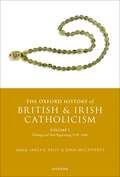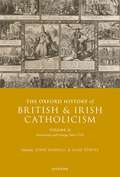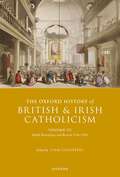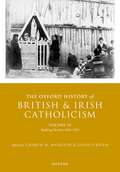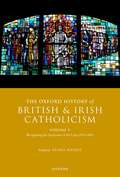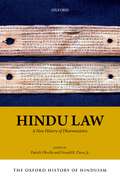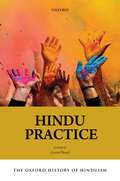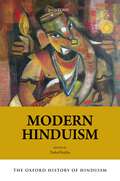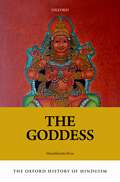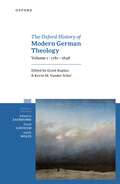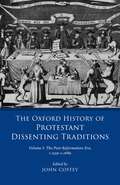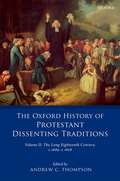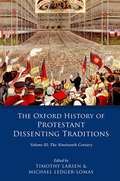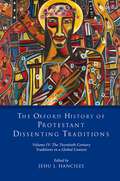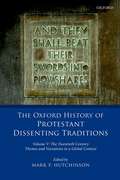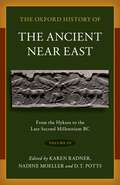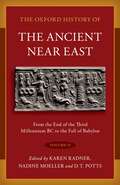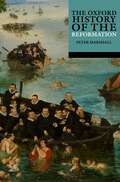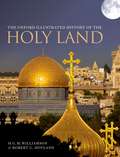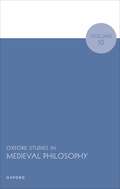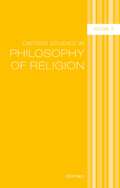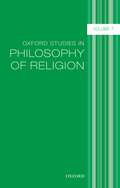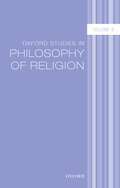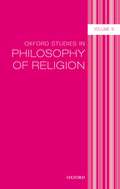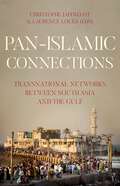- Table View
- List View
The Oxford History of British and Irish Catholicism, Volume I: Endings and New Beginnings, 1530-1640 (Oxford History of British and Irish Catholicism)
The first volume of The Oxford History of British & Irish Catholicism explores the period 1530-1640, from Henry VIII's break with Rome to the outbreak of the civil wars in Britain and Ireland. It analyses the efforts to create Catholic communities after the officially implemented change in religion, as well as the start of initiatives that would set the course of British and Irish Catholicism, including the beginning of the missionary enterprise and the formation of a network of exile religious institutions such as colleges and convents. This work explores every aspect of life for Catholics in both islands as they came to grips with the constant changes in religious policies that characterised this 110-year period. Accordingly, there are chapters on music, on literature in the vernaculars, on violence and martyrdom, and on the specifics of the female experience. Anxiety and the challenges of living in religiously mixed societies gave rise to new forms of creativity in religious life which made the Catholic experience much more than either plain continuity or endless endurance. Antipopery, or the extent to which Catholics became a symbolic antitype for Protestants, became in many respects a kind of philosophy about which political life in England, Scotland, and colonised Ireland began to revolve. At the same time the legal frameworks across both Britain and Ireland which sought to restrict, fine, or exclude Catholics from public life are given close attention throughout, as they were the daily exigencies which shaped identity just as much as devotions, liturgy, and directives emanating from the Catholic Reformation then ongoing in continental Europe.
The Oxford History of British and Irish Catholicism, Volume II: Uncertainty and Change, 1641-1745 (Oxford History of British and Irish Catholicism)
The second volume of The Oxford History of British & Irish Catholicism traces the fortunes of Catholic communities in England, Wales, Scotland, and Ireland across a period of great uncertainty and change. From the outset of the Civil Wars in 1641 to the Jacobite rising of 1745, Catholics in the three kingdoms were varied in their responses to tumultuous events and tantalising opportunities. The competing forces of dynamism and conservatism within these communities saw them constantly seeking to re-situate or re-imagine themselves as their relationship to the state, to Protestantism, to continental Europe, as well as the wider world beyond, changed and evolved. Consciously transnational, the volume moves away from insular conceptualisations of Catholicism and instead stresses connections with the European continent and beyond. Early chapters give broad overviews of the experience of Catholics in the period, tracking key events and important developments from 1641 to 1745. Chapters then address specific aspects of Catholicism, including empire and overseas missions, missionary activity, devotion, spirituality, trade, material culture, music, and architecture, among others, revealing a complex, rich and varied history of Catholicism in the period.
The Oxford History of British and Irish Catholicism, Volume III: Relief, Revolution, and Revival, 1746-1829 (Oxford History of British and Irish Catholicism)
The third volume of The Oxford History of British and Irish Catholicism examines the period from the defeat of the Jacobite army at the battle of Culloden in 1746 to the enactment of Catholic emancipation in 1829. The first part of the volume offers a chronological overview tracing the decline of Jacobitism, the easing of penal legislation which targeted Catholics, the complex impact of the French Revolution, the debates about the place of Catholics in the post-Union state, and - following the mass mobilisation of Irish Catholics - the passage of emancipation. The second part of the volume shows that this political history can only be properly understood with reference to the broader transformations that occurred in the later eighteenth and early nineteenth centuries. The period witnessed the expansion of Catholic infrastructure (pastoral structures, chapel building, elementary education and finances) and changes in Catholic practice, for example in liturgy and devotion. The growing infrastructure and more public profession of Catholicism occurred in a society where anti-Catholicism remained a force, but the volume also addresses the accommodations and interactions with non-Catholics that attended daily life. Crucially, the transformations of this period were international, as well as national. The volume examines the British and Irish convents, colleges, friaries and monasteries on the continent, especially during the events of the 1790s when many institutions closed and successor or new ones emerged at home. The international dimensions of British and Irish Catholicism extended beyond Europe too as the British Empire expanded globally, and attention is given to the involvement of British and Irish Catholics in imperial expansion. This volume addresses the literary, intellectual and cultural expressions of Catholicism in Britain and Ireland. Catholics produced a rich literature in English, Irish, Scots Gaelic and Welsh, although the volume shows the disparities in provision. They also engaged with and participated in the Catholic Enlightenment, particularly as they grappled with the challenges of accommodation to a Protestant constitution. This also had consequences for the public expression of Catholicism and the volume concludes by exploring the shifting expression of belief through music and material culture.
The Oxford History of British and Irish Catholicism, Volume IV: Building Identity, 1830-1913 (Oxford History of British and Irish Catholicism)
After 1830 Catholicism in Britain and Ireland was practised and experienced within an increasingly secure Church that was able to build a national presence and public identity. With the passage of the Catholic Relief Act (Catholic Emancipation) in 1829 came civil rights for the United Kingdom's Catholics, which in turn gave Catholic organisations the opportunity to carve out a place in civil society within Britain and its empire. This Catholic revival saw both a strengthening of central authority structures in Rome, (creating a more unified transnational spiritual empire with the person of the Pope as its centre), and a reinvigoration at the local and popular level through intensified sacramental, devotional, and communal practices. After the 1840s, Catholics in Britain and Ireland not only had much in common as a consequence of the Church's global drive for renewal, but the development of a shared Catholic culture across the two islands was deepened by the large-scale migration from Ireland to many parts of Britain following the Great Famine of 1845. Yet at the same time as this push towards a degree of unity and uniformity occurred, there were forces which powerfully differentiated Catholicism on either side of the Irish Sea. Four very different religious configurations of religious majorities and minorities had evolved since the sixteenth-century Reformation in England, Ireland, Scotland, and Wales. Each had its own dynamic of faith and national identity and Catholicism had played a vital role in all of them, either as 'other' or, (in the case of Ireland), as the majority's 'self'. Identities of religion, nation, and empire, and the intersection between them, lie at the heart of this volume. They are unpacked in detail in thematic chapters which explore the shared Catholic identity that was built between 1830 and 1913 and the ways in which that identity was differentiated by social class, gender and, above all, nation. Taken together, these chapters show how Catholicism was integral to the history of the United Kingdom in this period.
The Oxford History of British and Irish Catholicism, Volume V: Recapturing the Apostolate of the Laity, 1914-2021 (Oxford History of British and Irish Catholicism)
The fifth volume of The Oxford History of British & Irish Catholicism—covering the period from the Great War, through the Second World War and the Second Vatican Council—surveys the transformed ecclesial landscape between the papacies of Benedict XV and Pope Francis. It explores the efforts of bishops, priests and people in Ireland and Scotland, Wales and England to respond to modern challenges and reintegrate the experiences and expertise of the laity into the ministry of the Church. Alongside the twentieth century's designation as an era of technological innovation, war, peace, globalization, decolonization and liberation, this period has also been designated 'the People's Century'. Viewed through the lens of the Catholic church in Britain and Ireland, these same dynamics are explored within thematic, synoptic chapters by leading scholars. As a century characterized by the rise, or better renewal of the apostolate of the laity, this edited collection traces the struggles to reconcile tradition, re-evaluate hierarchical authority, adapt to social and educational mobility, as well as to adjudicate serious challenges from outside and within—including inflammatory biopolitics and clerical sexual abuse—to religious belief and the legitimacy of the Church as an institution.
The Oxford History of Hinduism: A New History of Dharmaśāstra (The Oxford History Of Hinduism)
Through pointed studies of important aspects and topics of dharma in Dharmaśāstra, this comprehensive collection shows that the history of Hinduism cannot be written without the history of Hindu law. Part One provides a concise overview of the literary genres in which Dharmasastra was written with attention to chronology and historical developments. This study divides the tradition into its two major historical periods—the origins and formation of the classical texts and the later genres of commentary and digest—in order to provide a thorough, but manageable overview of the textual bases of the tradition. Part Two presents descriptive and historical studies of all the major substantive topics of Dharmasastra. Each chapter offers readers with salest knowledge of the debates, transformations, and fluctcating importance of each topic. Indirectly, readers will also gain insight into the ethos or worldview of religious law in Hinduism, enabling them to get a feel for how dharma authors thought and why. Part Three contains brief studies of the impact and reception of Dharmasastra in other South Asian cultural and textual traditions. Finally, Part Four draws inspiration from "critical terms" in contemporary legal and religious studies to analyze Dharmasastra texts. Contributors offer interpretive views of Dharmasastra that start from hermeneutic and social concerns today.
The Oxford History of Hinduism: Hindu Practice (Oxford History Of Hinduism)
Traditions of asceticism, yoga, and devotion (bhakti), including dance and music, developed in Hinduism over long periods of time. Some of these practices, notably those denoted by the term yoga, are orientated towards salvation from the cycle of reincarnation and go back several thousand years. These practices, borne witness to in ancient texts called Upaniṣads, as well as in other traditions, notably early Buddhism and Jainism, are the subject of this volume in the Oxford History of Hinduism. Practices of meditation are also linked to asceticism (tapas) and its institutional articulation in renunciation (saṃnyăsa). There is a range of practices or disciplines from ascetic fasting to taking a vow (vrata) for a deity in return for a favour. There are also devotional practices that might involve ritual, making an offering to a deity and receiving a blessing, dancing, or visualization of the master (guru). The overall theme—the history of religious practices—might even be seen as being within a broader intellectual trajectory of cultural history. In the substantial introduction by the editor this broad history is sketched, paying particular attention to what we might call the medieval period (post-Gupta) through to modernity when traditions had significantly developed in relation to each other. The chapters in the book chart the history of Hindu practice, paying particular attention to indigenous terms and recognizing indigenous distinctions such as between the ritual life of the householder and the renouncer seeking liberation, between 'inner' practices of and 'external' practices of ritual, and between those desirous of liberation (mumukṣu) and those desirous of pleasure and worldly success (bubhukṣu). This whole range of meditative and devotional practices that have developed in the history of Hinduism are represented in this book.
The Oxford History of Hinduism: Modern Hinduism (The Oxford History of Hinduism)
The Oxford History of Hinduism: Modern Hinduism focuses on developments resulting from movements within the tradition as well as contact between India and the outside world through both colonialism and globalization. Divided into three parts, part one considers the historical background to modern conceptualizations of Hinduism. Moving away from the reforms of the 19th and early 20th century, part two includes five chapters each presenting key developments and changes in religious practice in modern Hinduism. Part three moves to issues of politics, ethics, and law. This section maps and explains the powerful legal and political contexts created by the modern state—first the colonial government and then the Indian Republic—which have shaped Hinduism in new ways. The last two chapters look at Hinduism outside India focusing on Hinduism in Nepal and the modern Hindu diaspora.
The Oxford History of Hinduism: The Goddess (The Oxford History Of Hinduism)
The Oxford History of Hinduism: The Goddess provides a critical exposition of the Hindu idea of the divine feminine, or Devī, conceived as a singularity expressed in many forms. With the theological principles examined in the opening chapters, the book proceeds to describe and expound historically how individual manifestations of Devī have been imagined in Hindu religious culture and their impact upon Hindu social life. In this quest the contributors draw upon the history and philosophy of major Hindu ideologies, such as the Purāṇic, Tāntric, and Vaiṣṇava belief systems. A particular distinction of the book is its attention not only to the major goddesses from the earliest period of Hindu religious history but also to goddesses of later origin, in many cases of regional provenance and influence. Viewed through the lens of worship practices, legend, and literature, belief in goddesses is discovered as the formative impulse of much of public and private life. The influence of the goddess culture is especially powerful on women's life, often paradoxically situating women between veneration and subjection. This apparent contradiction arises from the humanization of goddesses while acknowledging their divinity, which is central to Hindu beliefs. In addition to studying the social and theological aspect of the goddess ideology, the contributors take anthropological, sociological, and literary approaches to delineate the emotional force of the goddess figure that claims intense human attachments and shapes personal and communal lives.
Oxford History of Modern German Theology, Volume 1: 1781-1848 (Oxford History of Modern German Theology)
From the closing decades of the eighteenth century, German theology has been a major intellectual force within modern western thought, closely connected to important developments in idealism, romanticism, historicism, phenomenology, and hermeneutics. Despite its influential legacy, however, no recent attempts have sought to offer an overview of its history and development. Oxford History of Modern German Theology, Vol. I: 1781-1848, the first of a three-volume series, provides the most comprehensive multi-authored overview of German theology from the period from 1781-1848. Kaplan and Vander Schel cover categories frequently omitted from earlier overviews of the time period, such as the place of Judaism in modern German society, race and religion, and the impact of social history in shaping theological debate. Rather than focusing on individual figures alone, Oxford History of Modern German Theology, Vol. I: 1781-1848 describes the narrative arc of the period by focusing on broader intellectual and cultural movements, ongoing debates, and significant events. It furthermore provides a historical introduction to each of the chronological subsections that divides the book. Moreover, unlike previous efforts to introduce this time period and geographical region, the volume offers chapters covering such previously neglected topics as religious orders, the influence of Romantic art, secularism, religious freedom, and important but overlooked scholarly initiatives such as the Corpus Reformatorum. Attention to such matters will make this volume an invaluable repository of scholarship and knowledge and an indispensable reference resource for decades to come.
The Oxford History of Protestant Dissenting Traditions, Volume I: The Post-Reformation Era, 1559-1689 (The Oxford History of Protestant Dissenting Traditions)
The Oxford History of Protestant Dissenting Traditions, Volume I traces the emergence of Anglophone Protestant Dissent in the post-Reformation era between the Act of Uniformity (1559) and the Act of Toleration (1689). It reassesses the relationship between establishment and Dissent, emphasising that Presbyterians and Congregationalists were serious contenders in the struggle for religious hegemony. Under Elizabeth I and the early Stuarts, separatists were few in number, and Dissent was largely contained within the Church of England, as nonconformists sought to reform the national Church from within. During the English Revolution (1640-60), Puritan reformers seized control of the state but splintered into rival factions with competing programmes of ecclesiastical reform. Only after the Restoration, following the ejection of two thousand Puritan clergy from the Church, did most Puritans become Dissenters, often with great reluctance. Dissent was not the inevitable terminus of Puritanism, but the contingent and unintended consequence of the Puritan drive for further reformation. The story of Dissent is thus bound up with the contest for the established Church, not simply a heroic tale of persecuted minorities contending for religious toleration. Nevertheless, in the half century after 1640, religious pluralism became a fact of English life, as denominations formed and toleration was widely advocated. The volume explores how Presbyterians, Congregationalists, Baptists, and Quakers began to forge distinct identities as the four major denominational traditions of English Dissent. It tracks the proliferation of Anglophone Protestant Dissent beyond England—in Wales, Scotland, Ireland, the Dutch Republic, New England, Pennsylvania, and the Caribbean. And it presents the latest research on the culture of Dissenting congregations, including their relations with the parish, their worship, preaching, gender relations, and lay experience.
The Oxford History of Protestant Dissenting Traditions, Volume II: The Long Eighteenth Century c. 1689-c. 1828 (The Oxford History of Protestant Dissenting Traditions)
The five-volume Oxford History of Dissenting Protestant Traditions series is governed by a motif of migration ('out-of-England'). It first traces organized church traditions that arose in England as Dissenters distanced themselves from a state church defined by diocesan episcopacy, the Book of Common Prayer, the Thirty-Nine Articles, and royal supremacy, but then follows those traditions as they spread beyond England -and also traces newer traditions that emerged downstream in other parts of the world from earlier forms of Dissent. Secondly, it does the same for the doctrines, church practices, stances toward state and society, attitudes toward Scripture, and characteristic patterns of organization that also originated in earlier English Dissent, but that have often defined a trajectory of influence independent ecclesiastical organizations. The Oxford History of Protestant Dissenting Traditions, Volume II charts the development of protestant Dissent between the passing of the Toleration Act (1689) and the repealing of the Test and Corporation Acts (1828). The long eighteenth century was a period in which Dissenters slowly moved from a position of being a persecuted minority to achieving a degree of acceptance and, eventually, full political rights. The first part of the volume considers the history of various dissenting traditions inside England. There are separate chapters devoted to Presbyterians, Congregationalists, Baptists and Quakers—the denominations that traced their history before this period—and also to Methodists, who emerged as one of the denominations of 'New Dissent' during the eighteenth century. The second part explores that ways in which these traditions developed outside England. It considers the complexities of being a Dissenter in Wales and Ireland, where the state church was Episcopalian, as well as in Scotland, where it was Presbyterian. It also looks at the development of Dissent across the Atlantic, where the relationship between church and state was rather looser. Part three is devoted to revivalist movements and their impact, with a particular emphasis on the importance of missionary societies for spreading protestant Christianity from the late eighteenth century onwards. The fourth part looks at Dissenters' relationship to the British state and their involvement in the campaigns to abolish the slave trade. The final part discusses how Dissenters lived: the theology they developed and their attitudes towards scripture; the importance of both sermons and singing; their involvement in education and print culture and the ways in which they expressed their faith materially through their buildings.
The Oxford History of Protestant Dissenting Traditions, Volume III: The Nineteenth Century (The Oxford History of Protestant Dissenting Traditions)
The five-volume Oxford History of Dissenting Protestant Traditions series is governed by a motif of migration ('out-of-England'). It first traces organized church traditions that arose in England as Dissenters distanced themselves from a state church defined by diocesan episcopacy, the Book of Common Prayer, the Thirty-Nine Articles, and royal supremacy, but then follows those traditions as they spread beyond England -and also traces newer traditions that emerged downstream in other parts of the world from earlier forms of Dissent. Secondly, it does the same for the doctrines, church practices, stances toward state and society, attitudes toward Scripture, and characteristic patterns of organization that also originated in earlier English Dissent, but that have often defined a trajectory of influence independent ecclesiastical organizations. The Oxford History of Protestant Dissenting Traditions, Volume III considers the Dissenting traditions of the United Kingdom, the British Empire, and the United States in the nineteenth century. It provides an overview of the historiography on Dissent while making the case for seeing Dissenters in different Anglophone connections as interconnected and conscious of their genealogical connections. The nineteenth century saw the creation of a vast Anglo-world which also brought Anglophone Dissent to its apogee. Featuring contributions from a team of leading scholars, the volume illustrates that in most parts of the world the later nineteenth century was marked by a growing enthusiasm for the moral and educational activism of the state which plays against the idea of Dissent as a static, purely negative identity. This collection shows that Dissent was a political and constitutional identity, which was often only strong where a dominant Church of England existed to dissent against.
The Oxford History of Protestant Dissenting Traditions, Volume IV: The Twentieth Century: Traditions in a Global Context (The Oxford History of Protestant Dissenting Traditions)
The five-volume Oxford History of Protestant Dissenting Traditions series is governed by a motif of migration ('out-of-England'). It first traces organized church traditions that arose in England as Dissenters distanced themselves from a state church defined by diocesan episcopacy, the Book of Common Prayer, the Thirty-Nine Articles, and royal supremacy, but then follows those traditions as they spread beyond England-and also traces newer traditions that emerged downstream in other parts of the world from earlier forms of Dissent. Secondly, it does the same for the doctrines, church practices, stances toward state and society, attitudes toward Scripture, and characteristic patterns of organization that also originated in earlier English Dissent, but that have often defined a trajectory of influence independent ecclesiastical organizations. Volume IV examines the globalization of dissenting traditions in the twentieth century. During this period, Protestant Dissent achieved not only its widest geographical reach but also the greatest genealogical distance from its point of origin. Covering Africa, Asia, the Middle East, America, Europe, Latin America, and the Pacific, this collection provides detailed examination of Protestant Dissent as a globalizing movement. Contributors probe the radical shifts and complex reconstruction that took place as dissenting traditions encountered diverse cultures and took root in a multitude of contexts, many of which were experiencing major historical change at the same time. This authoritative overview unambiguously reveals that 'Dissent' was transformed as it travelled.
The Oxford History of Protestant Dissenting Traditions, Volume V: The Twentieth Century: Themes and Variations in a Global Context (The Oxford History of Protestant Dissenting Traditions)
The five-volume Oxford History of Protestant Dissenting Traditions series is governed by a motif of migration ('out-of-England'). It first traces organized church traditions that arose in Britain and Ireland as Dissenters distanced themselves from a state church defined by diocesan episcopacy, the Book of Common Prayer, the Thirty-Nine Articles, and Royal Supremacy, but then follows those traditions as they spread beyond Britain and Ireland—and also analyses newer traditions that emerged downstream in other parts of the world from earlier forms of Dissent. Secondly, it does the same for the doctrines, church practices, stances toward state and society, attitudes toward Scripture, and characteristic patterns of organization that also originated in earlier British and Irish dissent, but that have often defined a trajectory of influence independent of ecclesiastical organizations. The Oxford History of Protestant Dissenting Traditions, Volume V follows the spatial, cultural, and intellectual changes in dissenting identity and practice in the twentieth century, as these once European traditions globalized. While in Europe dissent was often against the religious state, dissent in a globalizing world could redefine itself against colonialism or other secular and religious monopolies. The contributors trace the encounters of dissenting Protestant traditions with modernity and globalization; changing imperial politics; challenges to biblical, denominational, and pastoral authority; local cultures and languages; and some of the century's major themes, such as race and gender, new technologies, and organizational change. In so doing, they identify a vast array of local and globalizing illustrations which will enliven conversations about the role of religion, and in particular Christianity.
The Oxford History of the Ancient Near East: Volume III: From the Hyksos to the Late Second Millennium BC (Oxford History of the Ancient Near East)
This groundbreaking, five-volume series offers a comprehensive, fully illustrated history of Egypt and Western Asia (the Levant, Anatolia, Mesopotamia, and Iran), from the emergence of complex states to the conquest of Alexander the Great. Written by a diverse, international team of leading scholars whose expertise brings to life the people, places, and times of the remote past, the volumes in this series focus firmly on the political and social histories of the states and communities of the ancient Near East. Individual chapters present the key textual and material sources underpinning the historical reconstruction, paying particular attention to the most recent archaeological finds and their impact on our historical understanding of the periods surveyed. The third volume examines the period from 1600 to 1100 BC or in archaeological terms, the Late Bronze Age. Twelve chapters survey the history of the Near East and discuss the Hyksos state of Lower Egypt, Upper Egypt, and the Nubian kingdom of Kerma prior to the unification that resulted in the creation of the New Kingdom, the geo-political super power of the period. Contemporary imperial powers-the Hittites in Central Anatolia and Mittani in Upper Mesopotamia-are discussed, as are the appearance and growth of Assyria, the kingdom of Kassite Babylonia, the Elamites of southwestern Iran, and the Mycenaeans in the Aegean. Beyond the narrative history of each region considered, the volume treats a wide range of critical topics, including the absolute chronology; state formation and disintegration; the role of kingship, cult practice, and material culture in the creation and maintenance of social hierarchies; and long-distance trade-both terrestrial and maritime-as a vital factor in the creation of social, political, and economic networks that bridged deserts, oceans, and mountain ranges, binding together the extraordinarily diverse peoples and polities of Sub-Saharan Africa, the Near East, and Central Asia.
The Oxford History of the Ancient Near East: Volume II: From the End of the Third Millennium BC to the Fall of Babylon (Oxford History of the Ancient Near East)
This groundbreaking, five-volume series offers a comprehensive, fully illustrated history of Egypt and Western Asia (the Levant, Anatolia, Mesopotamia, and Iran), from the emergence of complex states to the conquest of Alexander the Great. Written by a diverse, international team of leading scholars whose expertise brings to life the people, places, and times of the remote past, the volumes in this series focus firmly on the political and social histories of the states and communities of the ancient Near East. Individual chapters present the key textual and material sources underpinning the historical reconstruction, paying particular attention to the most recent archaeological finds and their impact on our historical understanding of the periods surveyed. The second volume covers broadly the first half of the second millennium BC or in archaeological terms, the Middle Bronze Age. Eleven chapters present the history of the Near East, beginning with the First Intermediate Period and Middle Kingdom Egypt and the Mesopotamian kingdoms of Ur (Third Dynasty), Isin and Larsa. The complex mosaic of competing states that arose between the Eastern Mediterranean, the Anatolian highlands and the Zagros mountains of Iran are all treated, culminating in an examination of the kingdom of Babylon founded by Hammurabi and maintained by his successors. Beyond the narrative history of each region considered, the volume treats a wide range of critical topics, including the absolute chronology; state formation and disintegration; the role of kingship, cult practice and material culture in the creation and maintenance of social hierarchies; and long-distance trade-both terrestrial and maritime-as a vital factor in the creation of social, political and economic networks that bridged deserts, oceans, and mountain ranges, binding together the extraordinarily diverse peoples and polities of Sub-Saharan Africa, the Near East, and Central Asia.
The Oxford History of the Reformation (Oxford Histories)
'a vital resource' TLS 'Compelling collection' Literary Review The Reformation was a seismic event in history whose consequences are still unfolding in Europe and across the world. Martin Luther's protests against the marketing of indulgences in 1517 were part of a long-standing pattern of calls for reform in the Christian Church. But they rapidly took a radical and unexpected turn, engulfing first Germany, and then Europe, in furious arguments about how God's will was to be 'saved'. However, these debates did not remain confined to a narrow sphere of theology. They came to reshape politics and international relations; social, cultural, and artistic developments; relations between the sexes; and the patterns and performances of everyday life. They were also the stimulus for Christianity's transformation into a truly global religion, as agents of the Roman Catholic Church sought to compensate for losses in Europe with new conversions in Asia and the Americas. Covering both Protestant and Catholic reform movements, in Europe and across the wider world, this compact volume tells the story of the Reformation from its immediate, explosive beginnings, through to its profound longer-term consequences and legacy for the modern world. The story is not one of an inevitable triumph of liberty over oppression, enlightenment over ignorance. Rather, it tells how a multitude of rival groups and individuals, with or without the support of political power, strove after visions of 'reform'. And how, in spite of themselves, they laid the foundations for the plural and conflicted world we now inhabit.
The Oxford Illustrated History of the Holy Land (Oxford Illustrated History)
The Oxford Illustrated History of the Holy Land covers the 3,000 years which saw the rise of Judaism, Christianity, and Islam - and relates the familiar stories of the sacred texts with the fruits of modern scholarship. Beginning with the origins of the people who became the Israel of the Bible, it follows the course of the ensuing millennia down to the time when the Ottoman Empire succumbed to British and French rule at the end of the First World War. Parts of the story, especially as known from the Bible, will be widely familiar. Less familiar are the ways in which modern research, both from archaeology and from other ancient sources, sometimes modify this story historically. Better understanding, however, enables us to appreciate crucial chapters in the story of the Holy Land, such as how and why Judaism developed in the way that it did from the earlier sovereign states of Israel and Judah and the historical circumstances in which Christianity emerged from its Jewish cradle. Later parts of the story are vital not only for the history of Islam and its relationships with the two older religions, but also for the development of pilgrimage and religious tourism, as well as the notions of sacred space and of holy books with which we are still familiar today. From the time of Napoleon on, European powers came increasingly to develop both cultural and political interest in the region, culminating in the British and French conquests which carved out the modern states of the Middle East. Sensitive to the concerns of those for whom the sacred books of Judaism, Christianity, and Islam are of paramount religious authority, the authors all try sympathetically to show how historical information from other sources, as well as scholarly study of the texts themselves, enriches our understanding of the history of the region and its prominent position in the world's cultural and intellectual history.
Oxford Studies in Medieval Philosophy Volume 10 (Oxford Studies in Medieval Philosophy)
Oxford Studies in Medieval Philosophy showcases the best scholarly research in this flourishing field. The series covers all aspects of medieval philosophy, including the Latin, Arabic, and Hebrew traditions, and runs from the end of antiquity into the Renaissance. It publishes new work by leading scholars in the field, and combines historical scholarship with philosophical acuteness. The papers will address a wide range of topics, from political philosophy to ethics, and logic to metaphysics. OSMP is an essential resource for anyone working in the area.
Oxford Studies in Philosophy of Religion Volume 6 (Oxford Studies in Philosophy of Religion)
Oxford Studies in Philosophy of Religion is an annual volume offering a regular snapshot of state-of-the-art work in this longstanding area of philosophy that has seen an explosive growth of interest over the past half century. Under the guidance of a distinguished editorial board, it publishes exemplary papers in any area of philosophy of religion.
Oxford Studies in Philosophy of Religion, Volume 7 (Oxford Studies in Philosophy of Religion)
Oxford Studies in Philosophy of Religion is an annual volume offering a regular snapshot of state-of-the-art work in this longstanding area of philosophy that has seen an explosive growth of interest over the past half century. Under the guidance of a distinguished editorial board, it publishes exemplary papers in any area of philosophy of religion.
Oxford Studies in Philosophy of Religion Volume 8 (Oxford Studies in Philosophy of Religion #8)
Oxford Studies in Philosophy of Religion is an annual volume offering a regular snapshot of state-of-the-art work in this longstanding area of philosophy that has seen an explosive growth of interest over the past half century. Under the guidance of a distinguished editorial board, it publishes exemplary papers in any area of philosophy of religion.
Oxford Studies in Philosophy of Religion Volume 9 (Oxford Studies in Philosophy of Religion #9)
Oxford Studies in Philosophy of Religion is an annual volume offering a regular snapshot of state-of-the-art work in this longstanding area of philosophy that has seen an explosive growth of interest over the past half century. Under the guidance of a distinguished editorial board, it publishes exemplary papers in any area of philosophy of religion.
Pan-Islamic Connections: Transnational Networks Between South Asia and the Gulf
South Asia is today the region inhabited by the largest number of Muslims---roughly 500 million. In the course of the Islamisation process, which begaun in the eighth century, it developed a distinct Indo-Islamic civilisation that culminated in the Mughal Empire. While paying lip service to the power centres of Islam in the Gulf, including Mecca and Medina, this civilisation has cultivated its own variety of Islam, based on Sufism. Over the last fifty years, pan-Islamic ties have intensified between these two regions. Gathering together some of the best specialists on the subject, this volume explores these ideological, educational and spiritual networks, which have gained momentum due to political strategies, migration flows and increased communications. At stake are both the resilience of the civilisation that imbued South Asia with a specific identity, and the relations between Sunnis and Shias in a region where Saudi Arabia and Iran are fighting a cultural proxy war, as evident in the foreign ramifications of sectarianism in Pakistan. Pan-Islamic Connections investigates the nature and implications of the cultural, spiritual and socio-economic rapprochement between these two Islams.
